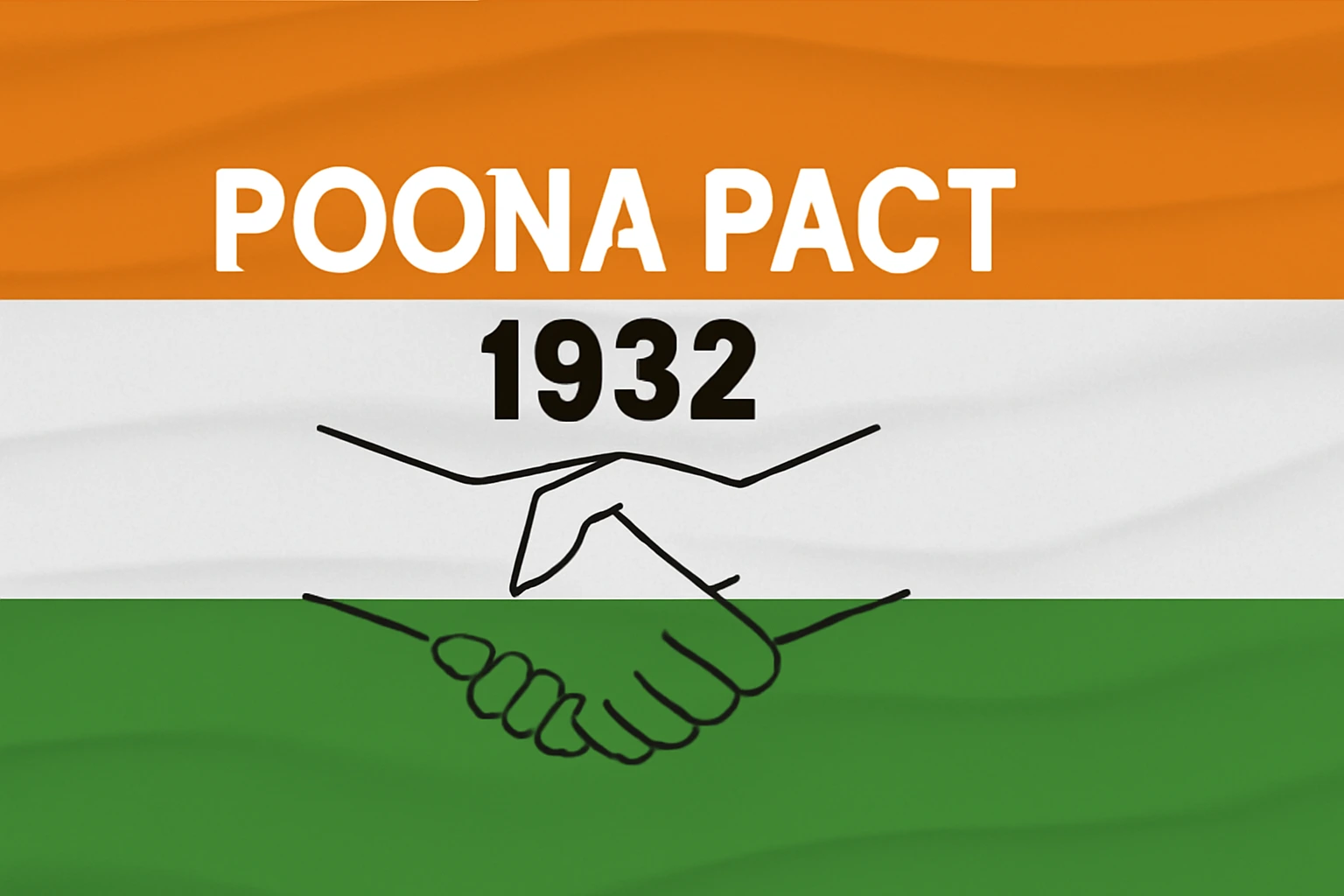The Poona Pact of 1932 was a landmark agreement between Mahatma Gandhi and Dr. B.R. Ambedkar that profoundly altered the course of Indian political and social history. For aspirants of UPSC and other state public service commissions, understanding its background, features, and significance is crucial for a nuanced grasp of India’s constitution-making process.
Background and Context
The origins of the Poona Pact lie in the British government’s policy of communal representation. In August 1932, British Prime Minister Ramsay MacDonald announced the Communal Award, which granted separate electorates for various religious and social groups, including Muslims, Sikhs, Anglo-Indians, and importantly, the “Depressed Classes”—the community now known as Dalits or Scheduled Castes. While the Depressed Classes’ leaders, led by Ambedkar, initially welcomed this move as a step toward genuine political empowerment, Gandhi saw it as an attempt to divide Hindu society. He argued that separate electorates for Dalits would not only fragment the Hindu community but also impede the larger struggle for independence by sowing permanent divisions.
In protest, Gandhi began a fast unto death on September 20, 1932, from Yerwada Jail, placing immense moral and political pressure on the Indian leadership. An urgent need arose for a mutually acceptable compromise between Gandhi and Ambedkar. Despite initial reluctance, Ambedkar engaged in intense negotiations, resulting in the historic Poona Pact on September 24, 1932.
Main Provisions of the Poona Pact
The agreement did away with the provision of separate electorates for the Depressed Classes. Instead, it introduced joint electorates with reserved seats. Specifically, the Pact reserved 148 seats for Dalits in various provincial legislatures—far more than the 71 seats originally allocated under the Communal Award. Elections to these seats would occur through a primary electoral college exclusively of Depressed Class voters, but the final candidates would face the general electorate.
In addition, 18% of the seats in the Central Legislature were to be reserved for Depressed Classes. The Pact also stipulated the fair and non-discriminatory recruitment of Dalits in public services and recommended earmarking a proper portion of educational grants for their benefit. These measures ensured not just token representation but meaningful participation and the gradual upliftment of the Depressed Classes via access to political, social, and educational opportunities.
Significance and Impact
The Poona Pact is considered a watershed in India’s constitutional journey. First, it brought the struggle for Dalit rights center stage, fundamentally shifting the focus from social to political emancipation. By securing a higher number of reserved seats and embedding joint electorates, the Pact both increased Dalit representation and checked potential social fragmentation. Its spirit and provisions directly influenced the system of reservation for Scheduled Castes and Tribes in India’s Constitution.
This agreement also cemented Ambedkar’s status as the undisputed leader of the Dalits and propelled him to the forefront of national politics. For Gandhi, the Pact was instrumental in maintaining Hindu unity and subsequently elevated the anti-untouchability movement within his political and social agenda. After the Pact, Gandhi launched the Harijan Sevak Sangh and a nationwide campaign against untouchability.
However, the Pact was not without controversy. Ambedkar later articulated his dissatisfaction, pointing out that separate electorates would have granted the Depressed Classes a “double vote,” seen as a crucial safeguard for their interests. Even so, the increased reservation, accepted by both communities, became a template for India’s future affirmative action programs.
Constitutional Legacy
The Poona Pact’s provisions found expression in several legislative and constitutional developments, most notably the Government of India Act, 1935, and India’s post-independence Constitution. The Pact shaped the system of political reservations that exists to this day and was a decisive moment in the recognition that the Depressed Classes constituted a political minority whose rights needed special protection in independent India.
Conclusion
In summary, the Poona Pact was a critical turning point in the nation’s march toward social justice and inclusive democracy. Any UPSC or state PSC aspirant must appreciate the Pact’s nuanced interplay of negotiation, conflict, and compromise as it laid the groundwork for modern India’s policies of reservation, social justice, and empowerment of marginalized groups.
Here are original, exam-focused MCQs on the Poona Pact, designed for UPSC and State PSC preparation:
1. The Poona Pact was signed in 1932 between which two prominent leaders?
A) Mahatma Gandhi and Jawaharlal Nehru
B) Mahatma Gandhi and Dr. B.R. Ambedkar
C) Dr. B.R. Ambedkar and Subhas Chandra Bose
D) Jawaharlal Nehru and Madan Mohan Malaviya
Answer: B) Mahatma Gandhi and Dr. B.R. Ambedkar
2. What was the main provision of the Poona Pact of 1932?
A) Introduction of separate electorates for Muslims
B) Abolishing reservations for Depressed Classes
C) Replacement of separate electorates with reserved seats for Depressed Classes in joint electorates
D) Granting of voting rights only to women
Answer: C) Replacement of separate electorates with reserved seats for Depressed Classes in joint electorates
3. The number of seats reserved for the Depressed Classes in provincial legislatures under the Poona Pact was increased from the Communal Award’s original allocation to what figure?
A) 32
B) 71
C) 147/148
D) 200
4. The background of the Poona Pact involved which British policy announcement that initially granted separate electorates to the Depressed Classes?
A) August Offer
B) Government of India Act 1919
C) Communal Award
D) Morley-Minto Reforms
5. Where was the Poona Pact signed?
A) Sabarmati Ashram
B) Yerwada Central Jail, Poona
C) London
D) Bombay High Court
Answer: B) Yerwada Central Jail, Poona
6. Which date marks the signing of the Poona Pact?
A) August 16, 1932
B) September 24, 1932
C) October 2, 1932
D) December 25, 1932
7. The Poona Pact’s provisions later influenced which constitutional safeguard in India?
A) Fundamental Rights
B) Directive Principles of State Policy
C) Reservation for Scheduled Castes and Scheduled Tribes
D) Emergency Provisions
Answer: C) Reservation for Scheduled Castes and Scheduled Tribes
8. The Poona Pact was signed after Gandhi undertook which form of protest?
A) Salt March
B) Fast unto death
C) Quit India movement
D) Dandi March
Answer: B) Fast unto death

